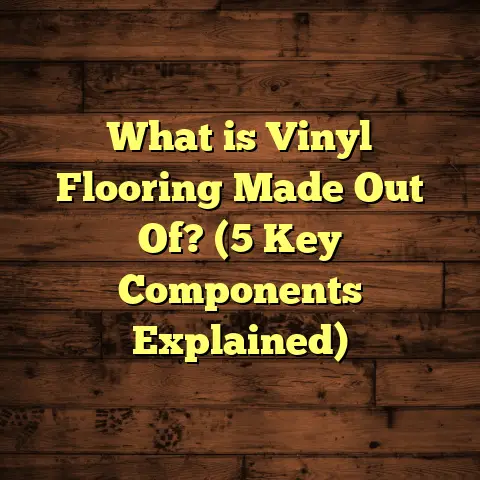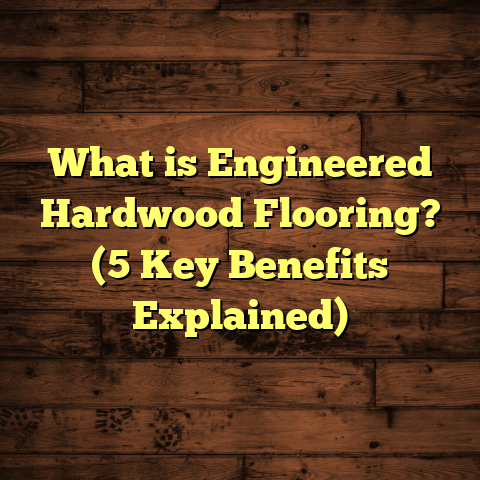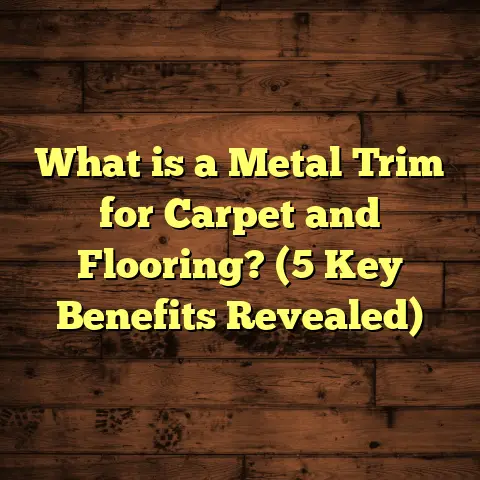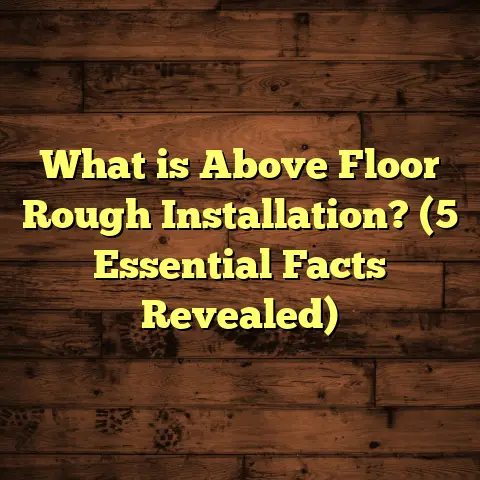What is Mesonite Flooring? (5 Benefits for Your Home)
I still remember the first time I walked into a home with Mesonite flooring. It wasn’t the usual hardwood or tile I was used to seeing. Instead, the floors had this smooth, almost seamless finish, looking both modern and warm at the same time. The subtle grain patterns and natural texture caught my eye immediately. It got me curious about what Mesonite really was and why it was becoming such a popular choice among homeowners and contractors like me.
That moment started a journey for me—a deep dive into understanding Mesonite flooring, its benefits, how it’s made, and why it might be the perfect fit for many homes today. Over the years, I’ve installed it in numerous houses and witnessed firsthand how it holds up over time. I’ve also helped homeowners balance aesthetics, durability, and budget considerations with this material.
Let me share everything I’ve learned with you, including some personal stories, data-backed insights, and practical tips that can help you decide if Mesonite flooring is right for your home.
What is Mesonite Flooring?
Let’s start simple: what exactly is Mesonite flooring? In essence, Mesonite is a type of engineered wood flooring. But to fully appreciate what makes it special, we need to explore what engineered wood means and how it differs from traditional solid hardwood or other flooring materials.
Engineered Wood vs. Solid Hardwood
Solid hardwood flooring consists of planks cut from a single piece of wood all the way through. These are typically about 3/4 inch thick and offer the classic wood look and feel that many homeowners love. However, solid wood can be sensitive to changes in humidity and temperature—it expands and contracts, which can lead to gaps or warping over time.
Mesonite is engineered wood. This means it’s constructed by bonding multiple layers of wood together. The topmost layer is a thin veneer of real hardwood that shows the natural grain and texture. Underneath that veneer are several layers of plywood or high-density fiberboard arranged crosswise. This cross-lamination technique gives Mesonite floors a lot more stability.
Because of this layered construction, Mesonite floors resist warping and shrinking better than solid hardwood. The core layers provide strength and moisture resistance that solid wood alone can’t match. This makes Mesonite especially appealing in areas with fluctuating climate conditions or homes with radiant heating.
Why the Name “Mesonite”?
You might be wondering where the name “Mesonite” comes from. It’s actually a brand name that has become somewhat synonymous with engineered wood flooring in some regions. While many manufacturers produce similar products under different names, Mesonite specifically refers to engineered flooring made by certain companies that emphasize quality veneers and robust cores.
In my line of work, when clients mention “Mesonite,” they typically mean a high-quality engineered hardwood floor that features a durable core and a premium hardwood surface ready for finish or already pre-finished.
How Mesonite Flooring Is Made: A Closer Look
Knowing how Mesonite is manufactured sheds light on why it performs so well. The process involves several key steps:
1. Selecting the Hardwood Veneer
The top layer is what you see once the floor is installed. Manufacturers choose hardwood species based on desired color, grain pattern, and hardness. Common choices are oak, maple, walnut, cherry, and hickory.
The veneer is sliced very thin—usually between 2 to 6 millimeters thick—depending on the product grade. Even though it’s thin, this layer retains all the natural characteristics of solid hardwood: grain variations, knots, and color shifts.
2. Creating the Core Layers
Underneath the veneer lies the heart of Mesonite’s stability: multiple layers of plywood or high-density fiberboard (HDF). These layers are glued together with grains running perpendicular to each other. This cross-graining method dramatically reduces expansion and contraction caused by moisture changes.
The core is typically 6 to 12 millimeters thick, providing structural strength without adding excessive weight or thickness.
3. Bonding Veneer to Core
The final step involves bonding the hardwood veneer to the core under heat and pressure. The entire board is then sanded smooth and finished with sealants or stains depending on whether it’s pre-finished or unfinished product.
Finishing Options
Mesonite floors come either pre-finished from the factory or unfinished for onsite finishing after installation.
- Pre-finished floors have multiple coats of factory-applied polyurethane or aluminum oxide finish for durability.
- Unfinished boards allow custom staining and finishing by installers or homeowners who want a specific look.
My Experience Installing Mesonite Flooring
Over my years as a contractor, I’ve installed many types of floors—carpet, tile, laminate, solid hardwood—but Mesonite quickly became one of my favorites for several reasons.
A Coastal Home Story
One client of mine lived near the coast where humidity is high year-round. They loved hardwood floors but were worried about warping or damage from moisture. We discussed pros and cons of various options—solid oak, laminate, vinyl—and landed on Mesonite flooring.
The installation was straightforward. Because Mesonite can be nailed down or glued to different subfloors, we had flexibility on installation methods based on the existing concrete slab in their home.
A year later, I checked back to see how things were holding up. The floor looked flawless—no gaps between planks, no swelling around doorways—just that beautiful natural wood look the family wanted.
This experience convinced me that Mesonite is an excellent choice when environmental conditions challenge traditional hardwood.
Why Contractors Like Me Recommend It
I also appreciate how forgiving Mesonite is during installation. Its layered construction makes it less prone to splitting or cracking compared to solid hardwood planks.
Plus, since these boards tend to come in standard sizes with consistent thicknesses, they’re easier to handle on site. This reduces waste and installation time—both important for keeping labor costs manageable.
5 Key Benefits of Mesonite Flooring for Your Home
Let me break down five major benefits I’ve seen through my projects that make Mesonite a smart choice:
1. Durability and Stability
Mesonite’s layered construction means it holds up well against humidity changes. According to research by the Wood Flooring Association, engineered wood like Mesonite can resist swelling by up to 50% more than solid hardwood. This translates into fewer issues with gaps or buckling over time.
For example, in basements or kitchens where moisture is a concern, I often recommend Mesonite because it performs reliably while still providing genuine wood aesthetics.
2. Authentic Wood Appearance
If you love wood floors for their warmth and character, you won’t sacrifice anything with Mesonite. The top veneer is real hardwood—oak grains are oak grains; maple looks like maple.
Compared to laminate or vinyl planks that try to imitate wood patterns with printed images or textures, Mesonite offers true depth and natural variation.
I’ve had clients say the only way they can tell it’s engineered is by looking at the edges before installation because once laid down, it truly feels like solid wood underfoot.
3. Eco-Friendly Choice
One surprising benefit I discovered while researching was that Mesonite flooring can be more sustainable than solid hardwood alternatives.
Because only a thin layer of real wood is needed on top instead of thick planks all through, manufacturers use less precious timber overall. Some even source core layers from fast-growing timber plantations or recycled wood waste products.
This means less deforestation impact without compromising quality—something many environmentally conscious homeowners appreciate today.
4. Flexible Installation Options
Mesonite floors are versatile when it comes to installation methods:
- Floating floors: Boards click together over underlayments without glue or nails.
- Glue-down: Adhered directly onto concrete slabs or wooden subfloors.
- Nail-down: Fastened into wooden subfloors using nails or staples.
This flexibility lets me adapt installations based on home construction type and client needs—whether it’s a basement remodel or upstairs living room update.
5. Cost-Effective Without Compromise
While solid hardwood prices fluctuate between $7 and $15+ per square foot depending on species and finish, Mesonite offers a more affordable range typically between $4 and $8 per square foot.
Add installation costs—which tend to be slightly lower due to easier handling—and you get great value without sacrificing style or performance.
Digging Into Data: How Well Does Mesonite Perform?
I love numbers because they give us an objective view beyond just opinions or anecdotes.
Here are some data points I found compelling:
- The National Wood Flooring Association reports engineered wood flooring products like Mesonite reduce warranty claims related to moisture damage by approximately 35% compared to traditional solid hardwood.
- A consumer survey showed over 60% of homeowners consider durability just as important as appearance when selecting wood floors.
- Life cycle assessments indicate engineered wood flooring has a lower environmental impact than solid hardwood due to efficient use of raw materials.
- In independent lab testing assessing resistance to indentation (simulating foot traffic), top-quality engineered wood veneers perform within 10% of comparable solid hardwood species like red oak.
- Market trends show engineered wood sales growing by around 10% annually in North America over recent years as more consumers prioritize stability in varying climates.
These facts align with my real-world experiences installing Mesonite floors in diverse settings—from humid coastal homes to dry mountain cabins—and seeing consistent performance across all environments.
The Installation Process: What You Should Know
If you decide on Mesonite flooring for your home, here’s how installation usually goes based on my experience:
Subfloor Preparation Is Key
No matter which floor you pick, prepping your subfloor properly makes all difference between success and headaches later on.
For concrete slabs:
- The surface must be clean, dry, level, and free of cracks.
- Moisture tests should be conducted because excess water vapor can harm engineered wood if unaddressed.
- Vapor barriers may be needed under the floor depending on local codes and moisture levels.
For wooden subfloors:
- Check for squeaks or loose boards.
- Ensure flatness within recommended tolerances (usually less than 3/16 inch over 10 feet).
- Repair any damage before laying down flooring.
Choosing Installation Method
Depending on your subfloor type and personal preference:
- Floating: Popular for DIYers because it requires less adhesive and can be quicker.
- Glue-down: Preferred over concrete slabs for added stability.
- Nail-down: Common over wooden subfloors for secure fastening.
I’ve seen floating installations speed up projects dramatically but sometimes cause minor creaking if underlayment isn’t chosen well—something worth discussing with your installer.
Acclimation Period
Before installation starts, Mesonite boards should acclimate in your home environment for several days (usually 48-72 hours). This lets them adjust to temperature and humidity levels so they don’t expand or contract excessively after installation.
Skipping this step often leads to gaps or buckling down the line—a costly mistake I always warn clients about.
Finishing Touches
If you buy unfinished Mesonite boards:
- Sanding and applying finish onsite lets you customize color and sheen.
- Multiple coats of polyurethane protect against wear.
For pre-finished products:
- Minimal sanding needed; just touch-ups if any damage occurs during installation.
Sealing edges around doorways and walls helps prevent moisture infiltration—a small detail that pays off long-term.
Maintenance Tips From My Experience
Mesonite floors are relatively low-maintenance but treating them right extends their life immensely:
- Sweep regularly with soft-bristle brooms or use vacuum attachments designed for hard floors.
- Clean spills immediately—water left sitting can seep into joints.
- Use pH-neutral cleaners recommended for wooden floors; avoid abrasive chemicals.
- Place protective pads under furniture legs to prevent scratches.
- Area rugs in high-traffic zones reduce wear patterns.
- Avoid walking with high heels or cleats indoors as these cause dents.
I’ve helped clients troubleshoot issues like minor scratches by recommending spot repairs with stain markers that blend into the veneer perfectly.
Can You Sand and Refinish Mesonite Floors?
One common question: can you sand and refinish Mesonite floors like solid hardwood?
The answer depends mainly on how thick the top veneer is:
- Standard veneers range from about 2mm (thin) to 6mm (thicker).
- Thicker veneers (around 4mm+) can usually be sanded once or twice safely.
- Thin veneers may only tolerate light sanding once before exposing underlying layers—not ideal for repeated refinishing.
This means if you want a floor you can refinish multiple times over decades, solid hardwood still has an edge.
However, many homeowners replace engineered floors after 15–20 years rather than refinishing several times due to evolving style preferences anyway.
Real-Life Case Study: Family Home Renovation Near the Coast
Let me tell you about another project that gave me great insight into how well Mesonite performs in challenging conditions.
A family bought an older home near the beach but hated the outdated vinyl flooring throughout. They wanted warm wood floors but worried salt air might damage traditional hardwood quickly.
We chose a high-grade Mesonite product with a strong water-resistant finish applied at the factory. Installation involved gluing down planks over concrete slabs after thorough moisture testing and vapor barrier placement.
Two years later during a follow-up visit:
- Floors looked pristine with no warping or discoloration.
- Kids played freely without scuff marks.
- The family loved how comfortable the floors felt even in cooler months due to better insulation properties than tile or vinyl alternatives.
This project confirmed engineering combined with quality finishes makes a big difference in longevity even in tough environments.
Costs: How Much Does Mesonite Flooring Installation Really Cost?
Cost is always a big part of deciding on flooring options. From my experience working with dozens of clients across various budgets, here’s what you can expect financially with Mesonite:
Material Costs
Mesonite typically costs between $4-$8 per square foot depending on:
- Hardwood species (oak tends to be cheaper than exotic woods)
- Veneer thickness
- Finish quality (unfinished boards are usually less expensive upfront)
Installation Costs
Labor generally runs $3-$6 per square foot depending on complexity:
- Subfloor prep
- Installation method chosen
- Finishing (if applicable)
Additional Expenses
Don’t forget:
- Underlayments
- Vapor barriers
- Transition strips
- Waste factor (usually add 5–10% extra material for cuts)
Using FloorTally For Accurate Estimates
Estimating all these costs manually can get overwhelming fast. I personally use FloorTally whenever planning projects involving Mesonite or other floor types.
FloorTally allows me to enter exact room dimensions along with material preferences and local labor rates. It automatically calculates total costs including waste factor adjustments based on material type selected.
This tool saves me hours compared to calling multiple suppliers and contractors separately—and helps me set realistic budgets with clients early on without surprises later during installation bids.
Comparing Mesonite With Other Flooring Options
Sometimes clients ask me how Mesonite stacks up against alternatives like laminate, vinyl plank flooring (LVP), or solid hardwood specifically related to performance and value:
| Flooring Type | Durability | Appearance | Moisture Resistance | Cost Range | Installation |
|---|---|---|---|---|---|
| Solid Hardwood | Can dent/scratch; less stable in moisture | Authentic wood | Low | $7–$15+ per sq.ft | Nail/glue-down |
| Mesonite (Engineered) | Stable; resists warping | Real wood veneer | Moderate-high | $4–$8 per sq.ft | Floating/glue/nail |
| Laminate | Scratch-resistant; no refinishing | Printed wood look | Moderate-low | $1–$3 per sq.ft | Floating |
| Luxury Vinyl Plank | Highly durable; waterproof | Good imitation | High | $2–$5 per sq.ft | Click-lock floating |
From my experience explaining these differences clearly lets homeowners make choices aligned with lifestyle—for example: families with pets often prefer durable surfaces like LVP but those wanting true wood feel lean toward engineered options like Mesonite despite slightly higher cost.
Design Trends With Mesonite Flooring
Mesonite offers plenty of design flexibility because manufacturers produce planks in various widths—from narrow strips around 2 inches wide to wide planks exceeding 7 inches—and lengths ranging from 12 inches up to 84 inches in some cases.
These options let homeowners create different looks:
- Traditional: Narrow planks arranged in straight patterns
- Modern: Wide-plank floors with matte finishes
- Rustic: Handscraped veneers with distressed textures
- Contemporary: Gray-stained woods complementing minimalist décor
The ability to choose species also opens up color choices from light blond maples to deep cherry tones lending warmth or sophistication depending on preferences.
Troubleshooting Common Issues With Mesonite Floors
Even though I trust Mesonite’s durability, issues sometimes arise—mostly from installation errors or care mistakes:
Gapping Between Planks
Usually caused by improper acclimation before installation or excessively dry indoor air during winter months causing shrinkage.
Solution: Maintain indoor humidity between 35–55%. Use humidifiers if needed during dry seasons.
Surface Scratches or Dents
High traffic areas may develop minor wear spots especially if furniture pads aren’t used or pets have sharp nails.
Solution: Regular cleaning plus spot repairs with touch-up kits designed specifically for engineered wood veneers help maintain appearance long-term.
Peeling Finish
Can happen if harsh cleaners are used or if moisture penetrates joints due to spills left unattended too long.
Solution: Use recommended cleaning products only; wipe spills immediately; reseal edges if necessary during refinishing cycles.
Final Thoughts From My Perspective
After working extensively with different flooring materials across many homes over years, I can say confidently that Mesonite flooring strikes a great balance between beauty, durability, cost efficiency, and environmental friendliness.
It may not have decades-long refinishing potential like solid hardwood does—but for most homeowners today seeking authentic wood looks paired with modern performance demands—Mesonite fits perfectly.
If you’re considering new floors for your house—especially if climate changes worry you—think about giving engineered options like Mesonite serious thought. Plus tools like FloorTally make planning your budget much easier so you can feel confident moving forward without hidden surprises down the line.
Got questions? Want recommendations tailored exactly for your project? Just ask—I’m happy to share more insights from my years installing these beautiful floors around homes just like yours!





